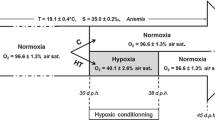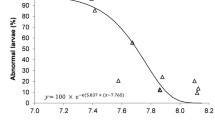Abstract
The objective of the present study is to examine the growth and energetic performance of juvenile turbot after exposure to contaminated sediment and during the subsequent recovery period with or without food limitation. We designed a two-step experiment by first exposing juvenile turbot to harbour sediment for 26 days and then transferring them to clean sea water with different frequencies of feeding for 35 days. Without food limitation, fish previously exposed to contaminated sediment compensated for weight, length and lipid reserve losses; we did not record any differences in size, Fulton’s K condition index and triacylglycerol/sterol (TAG/ST) ratio after the 35-day depuration period compared to the reference fish. This result could be related to the compensatory growth mechanism observed in a wide range of fish species following a period of growth depression. With food limitation during the 35-day depuration period, recovery growth was not sufficient to restore length and weight values similar to the reference fish. Moreover, turbot previously exposed to contaminated sediment and subsequently fed twice or once a week exhibited extremely low TAG/ST ratios, but the reference fish submitted to the same restrictive feeding conditions did not. This study indicates that juvenile fish affected by chemical pollution can improve their biological performance if pollution events are followed by a period of abundant food. However, if pollution events occur during periods of food scarcity, e.g. in winter, storage of energy reserves will be compromised.



Similar content being viewed by others
References
Abdalla HO, Fox DG, Thonney ML (1988) Compensatory gain by Holstein calves after underfeeding protein. J Anim Sci 66:2687–2695
Adams SM (1999) Ecological role of lipids in the health and success of fish populations. In: Arts MT, Wainman BC (eds) Lipids in freshwater ecosystems. Springer, New York, pp 132–160
Adams SM (2002) Biological indicators of aquatic ecosystem stress. American Fisheries Society Bethesda, Maryland, 621 pp
Ali M, Nicieza A, Wootton RJ (2003) Compensatory growth in fishes: a response to growth depression. Fish Fish 4:147–190
Álvarez D, Nicieza AG (2005) Compensatory responses ‘defend’ energy levels but not growth trajectories in brown trout, Salmo trutta L. Proc R Soc Lond B Biol Sci 272:601–607
Bavčević L, Klanjšček T, Karamarko V, Aničić I, Legović T (2010) Compensatory growth in gilthead sea bream (Sparus aurata) compensates weight, but not length. Aquaculture 301:57–63
Blanquet I, Oliva-Teles A (2010) Effect of feed restriction on the growth performance of turbot (Scophthalmus maximus L.) juveniles under commercial rearing conditions. Aquaculture Res 41:1255–1260
Bligh EG, Dyer WJ (1959) A rapid method of total lipid extraction and purification. Can J Biochem Physiol 37:911–917
Buckley L, Caldarone E, Ong TL (1999) RNA–DNA ratio and other nucleic acid-based indicators for growth and condition of marine fishes. Hydrobiologia 401:265–277
Caldarone EM, Wagner M, St. Onge-Burns J, Buckley LJ (2001) Protocol and guide for estimating nucleic acids in larval fish using a fluorescence microplate reader. Ref Doc 01–11:1–22, National Marine Fisheries Service, Woods Hole, MA
Calow P (1991) Physiological costs of combating chemical toxicants: ecological implications. Comp Biochem Physiol 100C:3–6
Cho SH, Kim KT, Choi IC, Jeon H, Kim DS (2012) Compensatory growth of grower olive flounder (Paralichthys olivaceus) with different feeding regime at suboptimal temperature. Asian Australas J Anim Sci 25:272–277
Clemmesen CM (1988) A RNA and DNA fluorescence technique to evaluate the nutritional condition of individual marine fish larvae. Meeresforschung Rep Mar Res 32:134–143
Congdon JD, Dunham AE, Hopkins WA, Rowe CL, Hinton TG (2001) Resource allocation-based life histories: a conceptual basis for studies of ecological toxicology. Environ Toxicol Chem 20:1698–1703
Critser DJ, Miller PS, Lewis AJ (1995) The effects of dietary protein concentration on compensatory growth in barrows and gilts. J Anim Sci 73:3376–3383
Driedger K, Weber LP, Rickwood CJ, Dube MG, Janz DM (2010) Growth and energy storage in juvenile fathead minnows exposed to metal mine waste water in simulated winter and summer conditions. Ecotoxicol Environ Saf 73:727–734
Eroldoğan OT, Kumlu M, Sezer B (2006) Effects of starvation and re-alimentation periods on growth performance and hyperphagic response of Sparus aurata. Aquaculture Res 37:535–537
Fonseca V, Serafim A, Compagny R, Bebianno MJ, Cabral H (2009) Effect of copper exposure on growth, condition indices and biomarker response in juvenile sole Solea senegalensis. Sci Mar 73:51–58
George SG, Hodgson PA, Tytler P, Todd K (1996) Inducibility of metallothionein mRNA expression and cadmium tolerance in larvae of a marine teleost, the turbot (Scophthalmus maximus). Fund Appl Toxicol 33:91–99
Gibson RN (1994) Impact of habitat quality and quantity on the recruitment of juvenile flatfishes. Neth J Sea Res 32(2):191–206
Gilliers C, Le Pape O, Désaunay Y, Morin J, Guérault D, Amara R (2006) Are growth and density quantitative indicators of essential fish habitat quality? An application to the common sole Solea solea nursery grounds. Estuar Coast Shelf Sci 69:96–106
Hayward RS, Noltie DB, Wang N (1997) Use of compensatory growth to double hybrid sunfish growth rates. Trans Am Fish Soc 126:316–322
Huang G, Wei L, Zhang X, Gao T (2008) Compensatory growth of juvenile brown flounder Paralichthys olivaceus (Temminck & Schlegel) following thermal manipulation. J Fish Biol 72:2534–2542
Hutchinson TH, Solbe J, Kloepper-sams P (1998) Analysis of the ecetoc aquatic toxicity (eat) database iii—comparative toxicity of chemical substances to different life stages of aquatic organisms. Chemosphere 36(1):129–142
Hurst TP (2007) Causes and consequences of winter mortality in fishes. J Fish Biol 71:315–345
Kerambrun E, Henry F, Perrichon P, Courcot L, Meziane T, Spilmont N, Amara R (2012) Growth and condition indices of juvenile turbot, Scophthalmus maximus, exposed to contaminated sediments: effects of metallic and organic compounds. Aquat Toxicol 108:130–140
Kerambrun E, Amara R, Henry F (2013) Effects of food limitation on 9 metal concentrations in liver and polycyclic aromatic hydrocarbon metabolites in bile of juvenile turbot (Scophthalmus maximus) previously exposed to contaminated sediments. Environ Toxicol Chem 32:2552–2557
Lemly AD (1993) Metabolic stress during winter increases the toxicity of selenium to fish. Aquat Toxicol 27:133–158
Mathers EM, Houlihan DF, McCarthy LO, Burren LJ (1993) Rates of growth and protein synthesis correlated with nucleic acid content in fry of rainbow trout, Oncorhynchus mykiss: effects of age and temperature. J Fish Biol 43:245–263
McGeer JC, Szebedinszky C, McDonald DG, Wood CM (2000) Effects of chronic sublethal exposure to waterborne Cu, Cd or Zn in rainbow trout. 1: iono-regulatory disturbance and metabolic costs. Aquat Toxicol 50:231–243
Meziane T, Tsuchiya M (2002) Organic matter in a subtropical mangrove-estuary subjected to wastewater discharge: origin and utilization by two macrozoobenthic species. J Sea Res 47(1):1–11
Miglavs I, Jobling M (1989) Effects of feeding regime on food consumption, growth rates and tissue nucleic acids in juvenile Arctic charr, Salvelinus alpinus, with particular respect to compensatory growth. J Fish Biol 34:947–957
Mohammed A (2013) Why are early life stages of aquatic organisms more sensitive to toxicants than adults? Pharmacology, Toxicology and Pharmaceutical Science New Insights into Toxicity and Drug Testing Edited by Sivakumar Gowder, ISBN 978-953-51-0946-4, 252 pages
Myszkowski L (2013) Growth, condition and food utilization in barbel Barbus barbus juveniles reared at different feeding periodicities with a dry diet. J Fish Biol 82:347–353
Navarro I, Gutierrez J (1995) Fasting and starvation. In: Hochachka PW, Mommsen TP, (eds) Metabolic biochemistry. Biochem Mol Biol Fish 4:393–434
Perago J, Barroso JB, Garcia-Salguero L, Higuera M, Lupianez JA (2001) Growth, protein-turnover rates and nucleic-acid concentrations in the white muscle of rainbow trout during development. Int J Biochem Cell Biol 33:1227–1238
Person-Le Ruyet J, Lacut A, Le Bayon N, Le Roux A, Pichavant K, Quéméner L (2003) Effects of repeated hypoxic shocks on growth and metabolism of turbot juveniles. Aquat Living Resour 16:25–34
Qian X, Cui Y, Xiong B, Yang Y (2000) Compensatory growth, feed utilization and activity in gibel carp, following feed deprivation. J Fish Biol 56:228–232
Robinson SM, Ware D (1988) Ontogenetic development of growth rates in larval Pacific herring, Clupeaharengus pallasi, measured with RNA/DNA ratios in the Strait of Georgia, British Columbia. Can J Fish Aquat Sci 45:1422–1429
Rowe CL, Hopkins WA, Congdon JD (2001) Metabolic costs incurred by crayfish (Procambarus acutus) in a trace element polluted habitat: further evidence of a common response among diverse taxonomic groups. Comp Biochem Physiol C 129:275–283
Saether BS, Jobling M (1999) The effects of ration level on feed intake and growth, and compensatory growth after restricted feeding, in turbot Scophthalmus maximus L. Aquaculture Res 30:647–653
Sargent J, Henderson RJ, Tocher DR (1989) The lipids. In: Halver JE (ed) Fish Nutrition. Academic Press, London, pp 154–209
Sevgili H, Hossu B, Emre Y, Kanyilmaz M (2012) Compensatory growth after various levels of dietary protein restriction in rainbow trout, Oncorhynchus mykiss. Aquaculture 344–349:126–134
Shuter BJ, Post JR (1990) Climate, population viability and the zoogeography of temperate fishes. Trans Am Fish Soc 119:314–336
Shuter BJ, Finstad AG, Helland IP, Zweimüller I, Hölker F (2012) The role of winter phenology in shaping the ecology of freshwater fish and their sensitivities to climate change. Aquat Sci 74:637–657
Suthers IM (2000) Significance of larval condition: comment on laboratory experiments. Can J Fish Aquat Sci 57:1534–1536
Tanaka Y, Gwak WS, Tanaka M, Sawada Y, Okada T, Miyashita S, Kumai H (2007) Ontogenetic changes in RNA, DNA and protein contents of laboratory-reared Pacific bluefin tuna Thunnus orientalis. Fish Sci 73:378–384
Van der Oost R, Beyer J, Vermeulen NPE (2003) Fish bioaccumulation and biomarkers in environmental risk assessment: a review. Environ Toxicol Pharmacol 13:57–149
Van Dijk PLM, Hardewig IH, Hölker F (2005) Energy reserves during food deprivation and compensatory growth in juvenile roach: the importance of season and temperature. J Fish Biol 66:167–181
Wu L, Deng H, Geng Z, Wang G (2006) Effects of protein restriction with subsequent realimentation on growth performance of juvenile Japanese flounder, Paralichthys olivaceus. Acta Ecol Sin Chin 26:3711–3717
Acknowledgments
This work was supported by the post Grenelle programme 190, DEVIL, of the French Ministry for Ecology and the Franco-British INTERREG IVA European project, DIESE. We thank A. Benazza, V. Cornille, L. Courcot, A. Delegrange, J. Denis, M. Lareal and C. Mahfouz for their help during experimental assays. Thanks to Annie Buchwalter for revision of the English grammar and syntax (http://anniebuchwalter.byethost16.com/).
Author information
Authors and Affiliations
Corresponding author
Additional information
Responsible editor: Philippe Garrigues
Rights and permissions
About this article
Cite this article
Kerambrun, E., Henry, F., Rabhi, K. et al. Effects of chemical stress and food limitation on the energy reserves and growth of turbot, Scophthalmus maximus . Environ Sci Pollut Res 21, 13488–13495 (2014). https://doi.org/10.1007/s11356-014-3281-1
Received:
Accepted:
Published:
Issue Date:
DOI: https://doi.org/10.1007/s11356-014-3281-1




